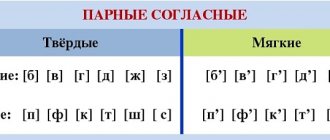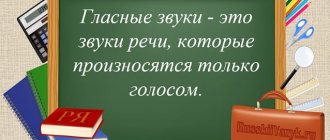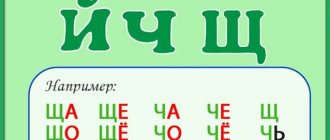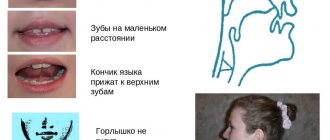- home
- Directories
- Handbook of Russian for elementary school
- Sounds and letters
In spoken language, words are made up of sounds . In written language, words are made up of letters . We pronounce and hear sounds, and we write and see letters (when we read). In writing, sounds are represented by letters.
We also use letters to indicate sounds, but we put them in square brackets. This is a phonetic notation of letters.
For example: sound [m], letter - “em”
The phonetic notation of letters is a transcription . It helps us understand how we speak, reflects the living sound of speech, and teaches us how to pronounce words correctly.
When preparing a transcription, consider:
- it is formatted in square brackets
- each sound corresponds to one sign
- capital letter is not used
- Words must be stressed
- the softness of a consonant is indicated by the symbol [ ' ] - polka - [pol' ka], leaf - [l' source]
- the longitude of a sound is indicated by the symbol [ ¯ ] - it is used when two letters make one sound: quarrel - [quarrel]
Stress placement is very important for correct phonetic notation. Stress, its features and rules of placement in the Russian language are studied by the science of accentology .
There are sounds: vowels and consonants .
The letters are:
- letters denoting vowel sounds (a, o, u and others)
- letters denoting consonants (m, r, k, b and others)
- letters that do not represent sounds (ъ, ь)
The Russian language has more sounds than letters.
To perform phonetic analysis means to characterize all the sounds that make up the word to be analyzed.
Share with friends on social networks:
How to distinguish between sounds and letters?
It is easy to distinguish between these concepts. We write down letters, draw them, see them. They look like this: A, e, p, U, M, b. Letters are needed to translate spoken language into written language. We speak, sing, and hear sounds. They are written in square brackets: [p] [o] [l]. This recording is called transcription.
Are the number of sounds and letters the same in the Russian language?
The Russian language has 33 letters and 42 sounds.
There are much more sounds, because not every sound corresponds to a letter. The same letter can convey different sounds. Yes, the letter r
in the words
blow
and
blow
defines different sounds: hard
[r]
and soft
[r'].
On what basis are speech sounds divided?
Speech sounds are divided into vowels and consonants according to the degree of use of voice in them. When forming vowel sounds, air passes through the mouth freely. The oral cavity opens wide. Only the voice is heard.
When pronouncing consonant sounds, the air in the mouth encounters obstacles: tongue, palate, teeth, lips. For example, to pronounce [b], [p], you need to clench your lips more closely, and the sounds [v], [f] are pronounced through the gap between the teeth and lips. Every consonant sound has noise.
§237. Pronunciation of individual grammatical forms
Some grammatical forms of verbs, nouns, and adjectives are characterized by special rules for the pronunciation of sounds in suffixes and endings.
1. In verbs with the particle -с I in the indefinite form and in the third person singular and plural, at the junction of the ending and the particle, [ts] is pronounced: meet, meet meet ́ti [ts], mark, mark – mark ́ti [ts], to check in - mark ́[ts], to say goodbye - farewell ́[ts].
In the form of the imperative mood, at the place of the combination -t'sya , two soft sounds [t's''] sound: mark - mark [t's''], meet - wind ́ [t's''].
2. At the endings of the genitive case of the masculine and neuter forms of adjectives, numerals, pronouns -о go/-е in place of g it is pronounced [в]: big house (lake) – big ́[вь], blue flag (sea) – с ́не [v]. The same rule applies to the words today - se[v]o ́, total - ito [v]o ́.
| Note. In surnames ending in -a go ( Shembinago , Zhivago ), the sound [g] is pronounced. |
3. Graphic abbreviations found in the text, for example, initials with a surname, as well as abbreviations such as l (liter), m (meter), kg (kilogram), ha (hectare), p/y (“mailbox”), t .d. (etc.), with (page), etc. in reading are “deciphered”, i.e. “unfold” into full words. Graphic abbreviations exist only in written speech for visual perception only, and their literal reading is perceived either as a speech error or as irony, appropriate only in special situations.
↑ Contents ↑
Vowel sounds and letters
There are six vowel sounds in Russian:
[a], [o], [y], [e], [i], [s].
In writing, sounds are represented by ten vowel letters:
a, i, e, e, o, u, s, e, yu, i.
For example:
- [a] – a (March) and I (mint)
- [and] – and (cinema)
- [s] – s (mouse)
- [o] – o (walrus) and e (aunt)
- [e] – e (echo) and e (accuracy)
- [y] – y (hoopoe) and yu (humor).
The ten vowel letters are easy to remember in pairs.
What is special about e, e, yu, i?
The four iotized letters e, e, yu, i stand out among others by two abilities:
- influence the preceding consonant, making it soft: to love - [l'u]beat.
- breaks down into two sounds:
| I | [y'a] |
| E | [y'e] |
| Yo | [y'o] |
| YU | [y'u] |
In transcription (in the designation of sounds) the letters e, e, yu, i are not used. They were excluded from the soundtrack.
In what cases do iotated vowels split into two sounds?
The letters e, e, yu, i represent two sounds:
- if the words appear at the beginning: amber - [y'i] amber,
- after a vowel: lightning – lightning[y'a],
- after ь and ъ signs: shrink - shrink.
Why can vowel sounds be strong and weak?
The power of vowel sounds is given by a special place in a word - stress. Under stress, the sound is pronounced clearly: wolf, park, forest, table.
Weakens the vowel - unstressed position. Thus, vowels lose their strength and change in the words five - p[i]terka, diaper - p[i]lenka, since the sound [i] is unstressed.
The vowel sound is part of the structure of the syllable, for this reason there are as many syllables in a word as there are vowel sounds.
§238. Peculiarities of pronunciation of Russian names and patronymics
The combination of first name and patronymic is used in various situations, both in written and oral speech: in official decrees on awards, appointments, orders, lists, for example, on personnel records, the composition of production and educational groups, in business and private correspondence, in circulation to the interlocutor, in introducing and naming third parties.
In an environment of official, business communication between people, especially in the work of a teacher, translator, editor, lawyer, businessman, government or commercial employee, there is a need to address people by name and patronymic. Many Russian names and patronymics have pronunciation options that it is advisable to take into account in a given communication situation. So, when meeting a person, when introducing a person for the first time, a distinct, clear pronunciation that is close to the written form is recommended.
In all other cases, incomplete, contracted forms of pronunciation of names and patronymics, which have historically developed in the practice of literary oral speech, are acceptable.
1. Patronymics formed from male names starting with -i ( Vasily , Anatoly, Arkady, Grigory, Yuri, Evgeniy, Valery, Gennady ) end in the combinations -evich , -evna with a preceding separator ь : Vasilevich , Vasilevna ; Grigor'evich , Grigor'evna . _ When pronouncing female patronymics, these combinations are clearly preserved: Vasil evna , Anatoly evna , Grigory evna , etc. In male patronymics, full and contracted variants are allowed: Vasya ́[l' jв']ich and Vasily[l'ich], Anato ́[l' jьv']ich and Anato ́[l'ich], Grigo ́[р' jьв ']ich and Grigo ́[r'ich] , etc.
2. Patronymics formed from male names ending in -e y and -ay ( Aleksey, Andrey, Korney, Matvey, Sergey, Nikolay ) end in the combinations -eevich, -eevna, -aevich, -aevna: Alekseevich, Alekseevna, Nikolaevich, Nikolaevna . In their pronunciation, the literary norm allows both full and contracted variants: Alekse ́evich and Alekse ́[i]ch, Alekse ́evna and Alek[s'e ́]vna; Sergeevich and Serge ́[i]ch, Serge ́evna and Ser[g'e ] vna; Korneevich and Korne ́[i]ch, Korne ́evna and Kor[n'e ́ ]vna; Nikola ́evich and Nikola ́[i]ch, Nikola ́evna and Nikola ́[vn]a , etc.
3. Male patronymics ending in an unstressed combination -o vich can be pronounced both in full and contracted form: Anto ́novich and Anto ́n[y]ch, Alexa ́ndrovich and Alexa ́ndr[y]ch, Iva ́novich and Ivan ́n [y]h , etc. In female patronymics ending in the unstressed combination -o vna, full pronunciation is recommended: Alexander ovna, Boris ovna, Kirill ovna, Victor ovna, Oleg ovna , etc.
4. If the patronymic begins with and ( Ivanovich, Ignatievich, Isaevich ), then when pronounced with a name ending in a hard consonant, it turns into [s]: Pavel Ivanovich - Pavel[y]vanovich, Alexander Isaevich - Alexander[y]saevich .
5. Usually ov in female patronymics from names ending in n i m: Iva ́[n:]na, Anto ́[n:]a, Efi ́[mn]a, Maxi ́[n:]a.
6. -o in female patronymics from names ending in v is not pronounced Vyachesla ́[vn]a, Stanisla ́[vn]a.
↑ Contents ↑
Consonants and letters
The Russian language has 21 consonants and 36 consonant sounds. The discrepancy in quantity appears due to the fact that many consonants were paired according to deafness/voice, hardness/softness.
On what basis are consonants divided into voiceless and voiced?
Voiceless and voiced consonants are divided according to the presence of noise and voice when pronounced.
Voiceless consonants are characterized by noise. Voice and noise are involved in the formation of voiced consonants. Voiced and voiceless consonants help distinguish words:
- steam - bar,
- count – goal.
Most of the voiced and voiceless consonants, like soldiers, come into pairs.
But among the consonants there are single sounds.
How to distinguish between hard and soft consonants?
Soft and hard consonants differ in pronunciation. The main role when pronouncing soft consonants is played by the tongue. The middle part of the tongue rises to the palate.
Basically, hard and soft consonants are combined into pairs in orderly rows:
Unpaired sounds are considered:
- always hard consonants – [zh], [sh], [ts];
- always soft consonants – [h'], [h'], [th'].
In writing, soft consonant sounds are indicated by the symbol ['] at the top right: night - but [h'].
Why do we need color schemes?
When analyzing sounds and letters of a word, it is convenient to use color schemes. They help to visually determine what sounds a word consists of. There are established color correspondences for various sounds:
- Vowels are highlighted in red;
- Iotated vowels are colored green-red;
- Hard consonants are marked blue;
- Soft consonants are painted green.
Soft and hard signs are not distinguished by color, since they do not produce sounds.
§236. Pronunciation of some consonants
1. The consonant [g] in literary pronunciation is explosive, instant sounding, and when deafened, is pronounced as [k]: sn[k], bere[k]. g in its place , conventionally designated [ h ], does not correspond to the norm: [ h]ulya ́t, sapo[ h]i ́. The exception is the word God, at the end of which there is an [x].
2. Instead of h in the words of course, boring, scrambled eggs, trifling, birdhouse, bachelorette party, laundry, rag, rag-picker, in female patronymics ending in - and chna ( Nikitichna, Kuzminichna, Ilyinichna , etc.), as well as in the words that, in order, nothing is pronounced [sh] .
3. In the words man, defector in the place of the combination zhch , in the form of the comparative degree of adverbs tougher, harsher (and biting ) in the place stch , and also in the place of the combinations zch and sch it is pronounced [sch]: loader, customer, carver, subscriber, sandstone , happy, happiness, account, electronic counting, counter, self-financing, count, etc.
4. When several consonants accumulate in some combinations, one of them is not pronounced:
a) in combination stn is not pronounced [t]: ucha ́[s'n']ik, ve ́[s']nik, che ́[sn]y, me ́[sn]y, famous ́[sn]y, nena ́[sn]y, I ́ro[s]y;
b) in the combination zdn is not pronounced [d]: po ́[zn]o, pra ́[zn]ik, nae ́[zn]ik, but in the word abyss it is recommended to leave a weak sound [d];
c) in the combination stl, [t] is not pronounced scha [ s'l ']i ́vyy, envious ́[s'l']ivy, so ́ve[s'l']ivy; in the words bony and postlat [t] is preserved;
d) in combination stl, [t] is not pronounced in this case, a double consonant [ss] is formed: maximali ́[ss]kiy, turi ́[ss]kiy, rasi ́[ss]kiy.
5. In some words, with the accumulation of consonant sounds stk , zdk, ntk, ndk, [t] is not allowed daughter-in-law, trip, agenda, typist, bulky, laboratory assistant, student, patient, Irish, tartan, but: cloth shotla [ nc ] A.
6. Hard consonants before soft consonants can be softened:
a) it is necessarily softened before soft z and s: pe ́[n's']iya, prete ́[n'z']iya, rece ́[n'z']iya, face ́[n'z'] and I;
b) in combinations tv , dv can be softened t and d : Thursday, Tver, hard [t'v'] and [tv']; door, two, move [d'v] and [dv'];
c) in combinations of sound and sv z and can be softened : beast, ring [z'v'] and [zv']; light, candle, witness, holy [s'v] and [sv'], as well as in the word snake [z'm'] and [zm'];
d) n before soft t i d softens: ba[n't']ik, vi[n't']ik, zo[n't']ik, ve[n't']il, a[n' t']ichny, ko[n't']text, remo[n't']irovat, ba[n'd']it, I[n'd']iya, stip[n'd']iya, zo[n'd']irovat, i[n'd']ivid, ka[n'd']idat, blo[n'd']in.
↑ Contents ↑
Phonetic analysis of the word
Why do you need phonetic analysis of a word?
Phonetic analysis gives the sound characteristics of a word.
With its help, you can break down a word into letters and sounds. Match the number of letters and sounds. And find out the discrepancies between letters and sounds, if any.
What is the order of phonetic parsing?
Phonetic analysis is carried out in the following sequence.
- Indicate the number of syllables and indicate stress.
- Count the number of sounds and letters in a word.
- Describe vowel sounds: stressed/unstressed.
- Describe consonant sounds: voiced/voiceless, hard/soft.
An example of sound-letter parsing
To perform sound-letter analysis, we write down the word and put an emphasis on it. Let's divide it into phonetic syllables. Taking into account all the phonetic changes in the word, we write down the letters and the corresponding sounds of the word vertically in square brackets. Let's give a phonetic characteristic to each sound.
For example, let’s perform a phonetic analysis of the word “Christmas tree”:
Christmas tree [y' o la ch' n y']
e-lo-chny - 3 syllables. The first syllable is stressed.
- letter “е” - [й'] - consonant, voiced unpaired, soft unpaired;
- [o] - stressed vowel;
- letter “l” - [l] - voiced unpaired consonant, hard paired;
- the letter “o” - [a] - unstressed vowel;
- letter “ch” - [ch'] - consonant, voiceless unpaired, soft unpaired;
- letter “n” - [n] - voiced unpaired consonant, hard paired;
- the letter “s” - [s] - unstressed vowel;
- letter “th” - [th'] - consonant, voiced unpaired, soft unpaired.
The word “Christmas tree” has 7 letters and 8 sounds.
Additional material
If you have any difficulties performing sound-letter (phonetic) analysis of a word, you can always test yourself on the website phoneticonline.ru.
Recording sounds
In transcription, the softness of a consonant sound is indicated by adding the symbol ' to its notation. This is an apostrophe that appears in some loanwords.
For example, to indicate the softness of the sound P in transcription, you need to write [p']. The hardness of the sound is not indicated.
There's nothing complicated about it. Offer your child a simple task. He needs to write out from a group of words only those that contain soft consonants, and then transcribe them with an apostrophe. Just a few of these exercises, and he will quickly remember how softness is indicated.
Table of hard and soft sounds
All rules are collected in one table. At first glance, it may seem like gobbledygook to a child, but after accessible explanations and careful study, the new material will no longer seem so complicated.
Print and hang this picture in a visible place so that your child can learn these rules at any convenient time.
Always hard and soft sounds
Now it’s time to find out the names of those very rebels who did not want to surrender to the enemy without a fight. The sounds Ch, Shch and Y are always soft, but C, Zh, Sh can only be hard. These are six consonant sounds that are still waging their quiet war and do not want to submit to the power of vowels. It doesn't matter who they happen to be next door to. The steadfastness of these sounds is admirable.










